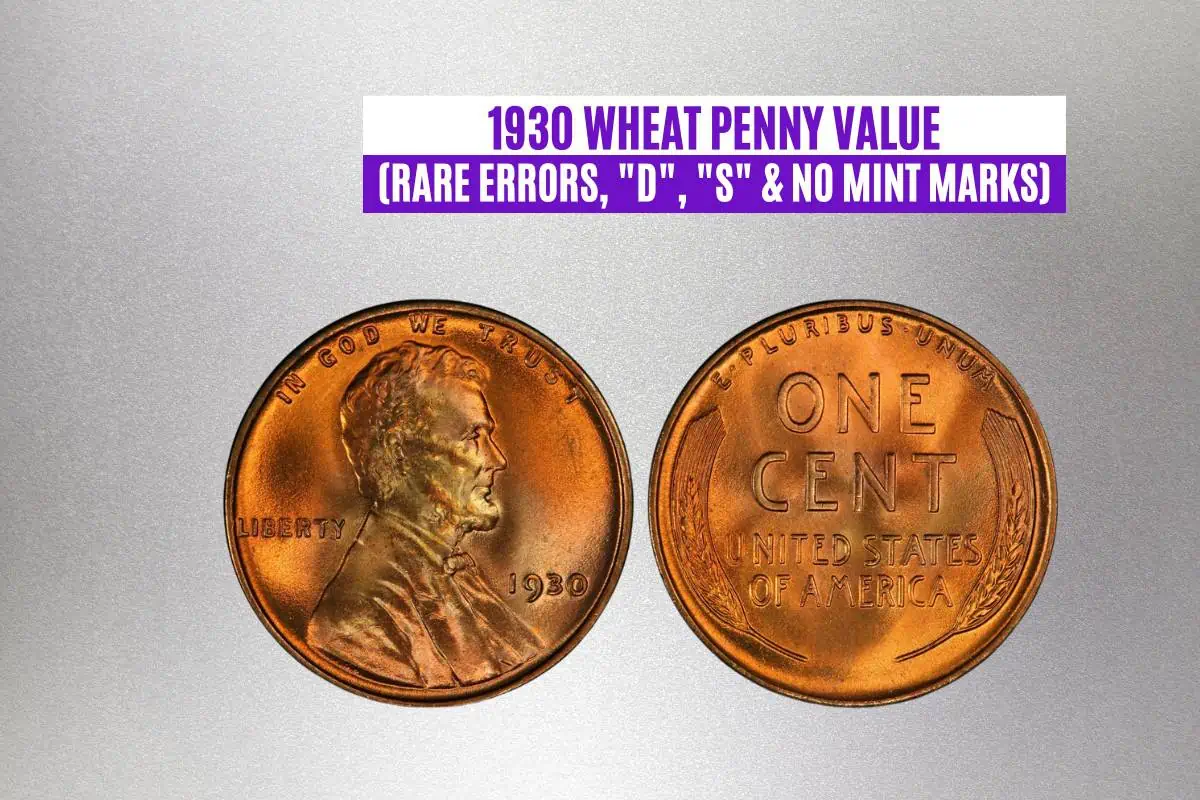What is the 1930 Wheat penny value? Experienced numismatics (coin collectors) might already know the answer to this question! However, it’s crucial to note that coin values change over time.
In this guide, we’ll discuss the history and current estimated values of the 1930 Lincoln Wheat cent. That way, you’ll have an excellent idea of just how much your 1930 pennies are worth and gain a greater appreciation for this copper one-cent coin.
1930 Lincoln Wheat Penny Value Chart
| Variety | MS-60 | MS-63 | MS-65 |
| 1930-P Penny BN | $4.75 | $10.25 | $23 |
| 1930-P Penny RB | / | $13.5 | $42 |
| 1930-P Penny RD | / | $16 | $65 |
| 1930-D Penny BN | $14 | $28 | $50 |
| 1930-D Penny RB | / | $33 | $67.5 |
| 1930-D Penny RD | / | $37.5 | $175 |
| 1930-S Penny BN | $10 | $15 | $35 |
| 1930-S Penny RB | / | $19 | $50 |
| 1930-S Penny RD | / | $27 | $110 |
1930 Lincoln Wheat Penny: History
The 1930 Lincoln Wheat penny wouldn’t exist if it weren’t for the artistic talents of Victor David Brenner.
Brenner (better known by his initials, VDB) was the sculptor responsible for creating the Lincoln Wheat penny’s design. The first of these pennies were released in 1909 and even featured Brenner’s initials, giving them their colloquial name; VDB Wheat pennies.
However, pennies produced from late 1909 onwards are essentially identical save for their date (which naturally changes from year to year). Still, without those first 1909 Lincoln Wheat pennies, the 1930 Lincoln Wheat cent would’ve probably looked very different.
1930 Lincoln Wheat Penny: Design
All 1930 Lincoln Wheat pennies feature the “Wheat Reverse” design created by Victor David Brenner in late 1908. This design shows an image of President Abraham Lincoln on the front (obverse) of the coin and two stalks of wheat on the back (reverse) side.
Obverse
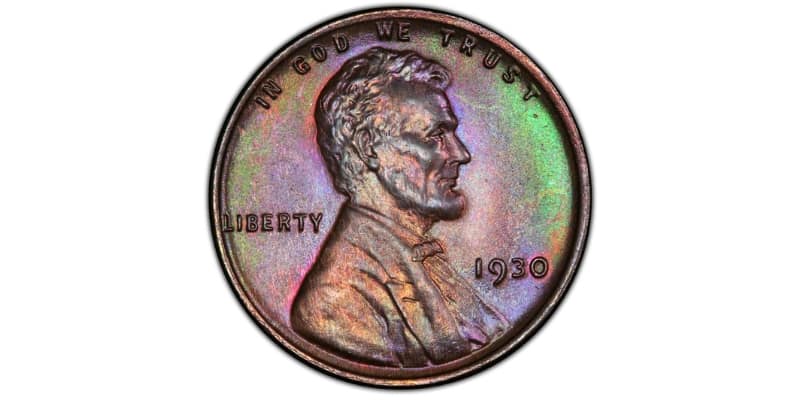
On the obverse side of the 1930 Lincoln Wheat penny, you’ll find:
- The motto “IN GOD WE TRUST” in an arch at the top of the coin
- A raised image (device) of President Abraham Lincoln, looking toward the right side of the coin
- The legend “LIBERTY” behind the device of Lincoln, slightly below the midpoint of the coin
- The year date (1930) on the lower right-hand side of the coin, slightly lower than Lincoln’s bow tie
- A mint mark (D or S) below the year date (or no mint mark for coins struck at the Philadelphia Mint facility)
Reverse
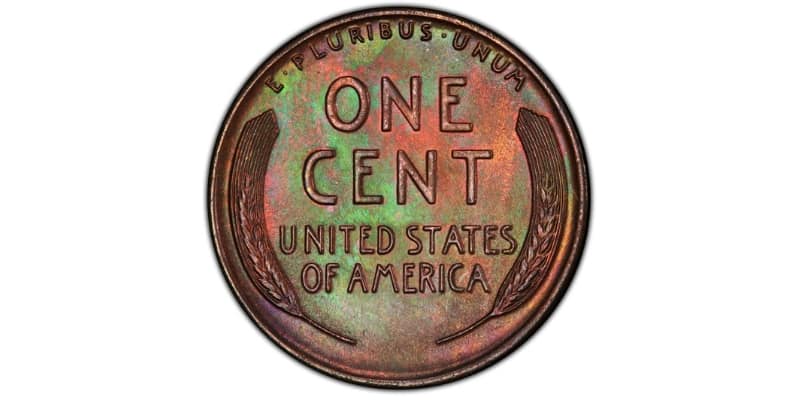
On the reverse side of the 1930 Lincoln Wheat penny, you’ll find:
- The motto “E PLURIBUS UNUM” in an arch at the top of the coin, separated by interpoints
- The coin denomination “ONE CENT” beneath the motto, extending to the approximate midpoint of the coin
- The coin’s issuing country, “UNITED STATES OF AMERICA,” beneath the denomination
- Two raised images (devices) of wheat stalks, curving toward the denomination and issuing country name and matching the natural curvature of the coin
1930 Lincoln Wheat Penny: Features and Specifications
All 1930 Lincoln Wheat pennies (except for error coins) have shared characteristics and features. For example, these one-cent coins:
- Feature the Lincoln Wheat (also called Wheat Reverse) design
- Weigh 3.11 g (about 0.11 oz)
- Are comprised of 90% copper and 5% zinc and tin
- Have a diameter of 19 mm (about 0.75 in)
How Much Is a 1930 Wheat Penny Worth?
A circulated 1930 Lincoln Wheat penny in good condition (G-4) has an estimated average value of about $0.15. The average value for a 1930 penny in about uncirculated condition (AU-50) is about $4.
Still, uncirculated condition (mint state) pennies have the highest average values. For example, a brown (BN) MS-66 1930-P Lincoln Wheat penny has an estimated value of $40.
1930 Lincoln Wheat Penny: Value Comparison
Coin value is almost always determined by condition, coloration, and scarcity.
The better a coin’s condition (and, by extension, its coloration), the higher its overall value. Naturally, rare coins (those with comparatively low mintages) are also more valuable than common ones, especially if they’re in excellent shape (mint state).
1930 Lincoln Wheat pennies are no exception. The value of any given penny from 1930 varies depending on its color (red, red and brown, or brown), condition, and mint mark.
Let’s explore all three types of 1930 Lincoln Wheat cents you can find to discover which are the most (and least) valuable.
1930-P (No Mint Mark) Lincoln Wheat Penny Value
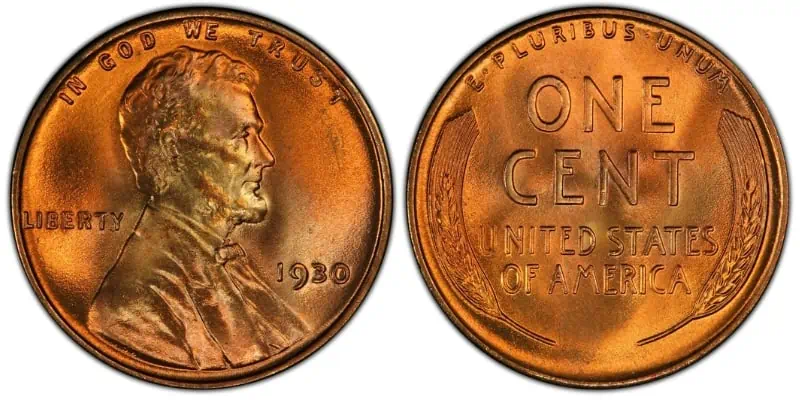
One of the defining characteristics of the 1930-P Lincoln Wheat penny is its lack of mint marks.
A mint mark is a small capital letter denoting the location where a coin was struck. But all pennies produced at the Philadelphia Mint facility (except 2017 Lincoln Shield pennies) have no mint marks.
So, if you have a 1930 Lincoln Wheat cent that doesn’t have a small “D” or “S” beneath the year date, you can confidently assume that your penny was struck at the Philadelphia Mint.
A 1930-P (No Mint Mark) Lincoln Wheat penny is worth between $0.05 (poor condition, brown) and $1,950 (MS-67+, red).
Because a penny’s color significantly influences its value, it’s vital to analyze the value of a 1930-P Lincoln Wheat cent by addressing its coloration: brown, red and brown, or red.
Brown
Most brown pennies get their coloration due to prolonged usage. After all, copper oxidizes when it comes into contact with air or water, causing it to transform from a bronze-red color to a muddy brown hue.
Because brown pennies are typically heavily circulated, they tend to be less valuable than their brighter red counterparts.
A brown (BN) 1930-P Lincoln Wheat cent in good condition (G-4) has an estimated value of $0.10. One in about uncirculated condition (AU-50) is worth $2.50. An MS-67 BN 1930 Lincoln Wheat penny has an estimated value of $110.
Red and Brown
Red and brown (RB) 1930-P Lincoln Wheat pennies have an estimated value of between $8 (MS-61) and $60 (MS-66).
Because these pennies are only slightly oxidized, they’re almost always in mint state condition. Consequently, you won’t find an RB 1930-P Lincoln Wheat cent in about uncirculated (AU) or good (G) condition.
Red
Red Lincoln Wheat cents retain their “like-new” coloration, making them highly collectible and aesthetically pleasing. These pennies are always in mint state (MS) condition.
A red (RD) 1930-P Lincoln Wheat cent is worth between $12 (MS-62) and $1,950 (MS-67+).
1930-D Lincoln Wheat Penny Value
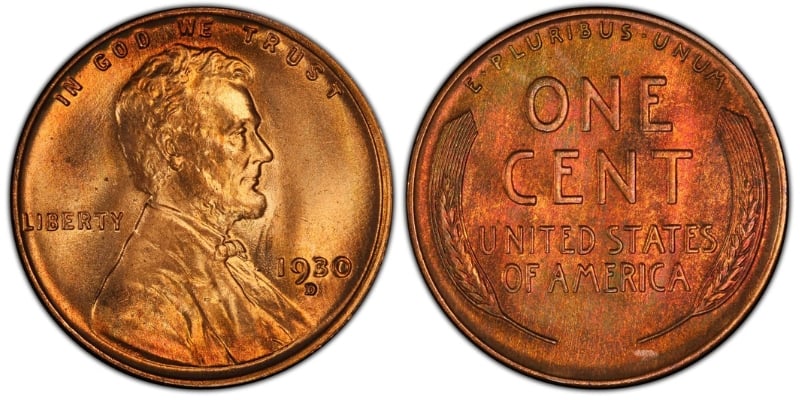
If you find a 1930 Lincoln Wheat penny with a small capital letter “D” beneath the year date, it’s a Denver Mint penny.
In 1930, the Denver Mint facility produced just over 40 million pennies. For reference, the Philadelphia Mint facility struck more than 157 million pennies in 1930.
Consequently, 1930-D Lincoln Wheat cents are rarer than “No Mint Mark” pennies from the same year.
Brown
A brown (BN) 1930-D Lincoln Wheat penny is worth between $0.25 (G-4) and $100 (MS-66). An about uncirculated (AU-50) BN 1930-D Lincoln Wheat cent has an estimated value of $5.
Red and Brown
Red and brown (RB) 1930-D Lincoln Wheat pennies are slightly more valuable than their brown-only counterparts. An RB 1930-D Lincoln Wheat cent has an estimated value ranging from $22 (MS-61) to $200 (MS-66).
Red
Of all 1930-D Lincoln Wheat pennies, red (RD) examples are the most valuable. These coins have an estimated value ranging from $30 (MS-62) to $6,900 (MS-67).
However, RD 1930-D Lincoln Wheat pennies aren’t quite as valuable as RD 1930-S Lincoln Wheat pennies!
1930-S Lincoln Wheat Penny Value
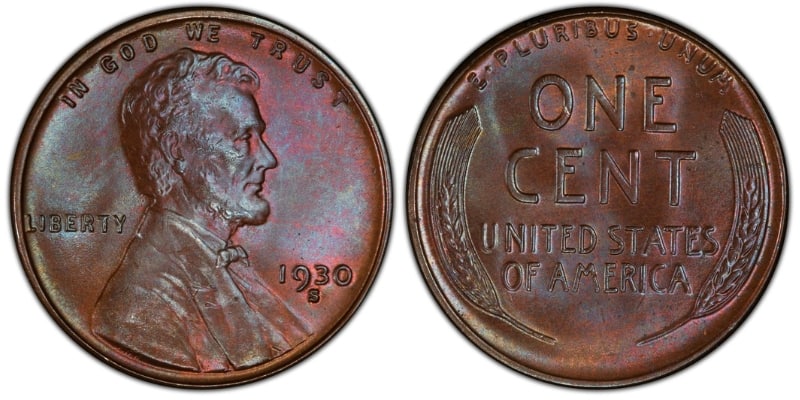
The San Francisco Mint had the lowest yield out of the three U.S. Mint facilities that produced pennies in 1930. This facility only struck about 24 million pennies in 1930.
For this reason, 1930-S Lincoln Wheat pennies are often more valuable than 1930-P or 1930-D Wheat Reverse coins. 1930-S Wheat pennies in exceptional condition (mint state, red) can be quite valuable.
Brown
A brown (BN) 1930-S Lincoln Wheat penny in good condition (G-4) has an approximate value of $0.25. A BN 1930-S Lincoln Wheat penny in about uncirculated condition (AU-50) is worth slightly more, with an estimated value of $6.50.
But a BN 1930-S Lincoln Wheat cent in mint state condition (MS-66+) is worth $85. That’s 8,500 times its original denomination ($0.01)!
Red and Brown
Red and brown (RB) 1930-S Lincoln Wheat pennies are worth between $13.50 (MS-61) and $110 (MS-66). Like other RB pennies, there are no uncirculated (AU) or good (G) condition examples of these coins.
Red
Red (RD) 1930-S Lincoln Wheat pennies have an estimated value ranging from $22 (MS-62) to $11,500 (MS-67). No other 1930 Lincoln Wheat penny has a higher estimated value than the RD 1930-S Lincoln Wheat cent.
Notably, the U.S. Mint didn’t produce any proof-strike pennies in 1930.
1930 Lincoln Wheat Penny: Rare Errors
The majority of coins produced by the U.S. Mint are error-free, but that doesn’t mean that all U.S. coins are perfect. Although the U.S. Mint has mostly perfected the coin-minting process, there are occasional mistakes that result in uncommon error coins.
But when discussing 1930 Lincoln pennies, there are three types of error coins you’ll encounter:
- The Lincoln Wheat penny repunched mintmark (RPM) coin
- The Lincoln Wheat penny struck-through error coin
- The Lincoln Wheat penny die crack error coin
Because these are non-standard coins, their values differ from those of error-free pieces. Let’s briefly discuss these error coins to discover their worth.
1930 Lincoln Wheat Penny Repunched Mintmark (RPM) Error
Error coins can exhibit a wide range of unique characteristics. For example, some coins are pressed on the wrong material (i.e., dime planchets instead of copper penny planchets), while others might have noticeable cracks resulting from worn-out, cracked coin dies.
But most error coins feature design flaws that stem from the striking process. The 1930 RPM (Repunched Mintmark) Lincoln Wheat penny is a fine example.
This error coin is the result of a faulty coin die.
When a coin die is altered to include a mintmark letter (D or S for 1930 pennies), the die can sometimes receive two impressions of the letter. This results in coins that show a slight overlap of the mint mark.
The Denver Mint was the only U.S. Mint facility that produced RPM pennies in 1930. Still, unless you’ve got a keen eye, you might not notice the error on the tiny “D” mint mark.
Still, the 1930 RPM Lincoln Wheat penny error coin can be quite valuable, regardless of coloration. In 2013, a brown (BN) 1930 RPM Lincoln Wheat cent (very fine condition, VF-25) sold at auction for $352!
1930 Lincoln Wheat Penny Struck-Through Error
Struck-through coins (also called strike-through coins) are so-called because their designs are “struck through” during the minting process, resulting in a blurred or damaged image on either the obverse (front) or reverse (back) sides.
Grease (used to ensure that coin dies don’t stick to planchets) is one of the most common culprits responsible for creating struck-through coins.
A struck-through 1930 Lincoln Wheat penny could be worth a few hundred dollars, depending on its condition, coloration, and the extent of the “blurring” caused by the strike-through.
1930 Lincoln Wheat Penny Die Crack Error
Most pennies start as blank copper discs. They become the recognizable one-cent pieces we know today only after being pressed by a coin die.
Coin dies are metal stamps engraved with a coin’s design. When pressed into a blank metal disc (planchet), these stamps produce an impression that gives a coin its design.
But while coin dies are quite durable, they do eventually wear out. Cracks in a die’s recessed design are a sure sign of wear, and they can produce coins with deep cracks and fissures.
1930 Lincoln Wheat pennies with significant die crack errors can sell for hundreds of dollars. However, those with smaller raised lines might only be worth a few bucks.
As with all other 1930 pennies, the condition and coloration can significantly impact the values of these error coins.
Frequently Asked Questions
Below you’ll find some of the most frequently asked questions regarding 1930 Lincoln Wheat pennies. So, if you’d like to get into coin collecting and have a few lingering questions about the 1930 Wheat Reverse penny, check out these questions and answers below.
How Many 1930 Pennies Have Been Found?
It’s challenging to determine how many 1930 Lincoln Wheat pennies have been discovered and added to private collections. That said, based on PCGS (Professional Coin Grading Service) estimates, there are probably about 22 million 1930 Lincoln Wheat pennies in existence today.
How Much Is a 1930 Wheat Penny Worth Today?
A 1930 Lincoln Wheat cent is worth between $0.05 (brown, poor condition) and $11,500 (red, MS-67).
Generally, the most valuable 1930 Lincoln Wheat pennies are those produced by the San Francisco Mint facility. After all, while the Philadelphia Mint facility struck more than 157 million pennies in 1930, the San Francisco Mint only produced a little over 24 million pennies during that year.
What’s the Highest Price Ever Paid for a 1930 Wheat Penny?
The auction record for the 1930 Lincoln Wheat penny was set in October 2020, when an MS-67+ RD 1930-D Lincoln Wheat penny sold at auction for $33,600.
This coin’s bright red coloration and exceptional condition are primarily responsible for its incredible auction price. Notably, an MS-67 RD 1930-S Lincoln Wheat penny sold at auction in 2004 for just shy of the record-setting amount, a hefty $33,350.
1930 Wheat Penny Value: Final Thoughts
So, what’s the 1930 Wheat penny value? The answer depends on the coin’s condition, coloration, and mint mark!
For example, a brown (BN) 1930-P Lincoln Wheat penny in good condition (G-4) is worth about $0.15. But a red (RD) 1930-S Lincoln Wheat penny in mint state condition (MS-67) has an estimated value of $11,500!
Would you like to learn more about the world’s most valuable coin? Check out these related articles now!

